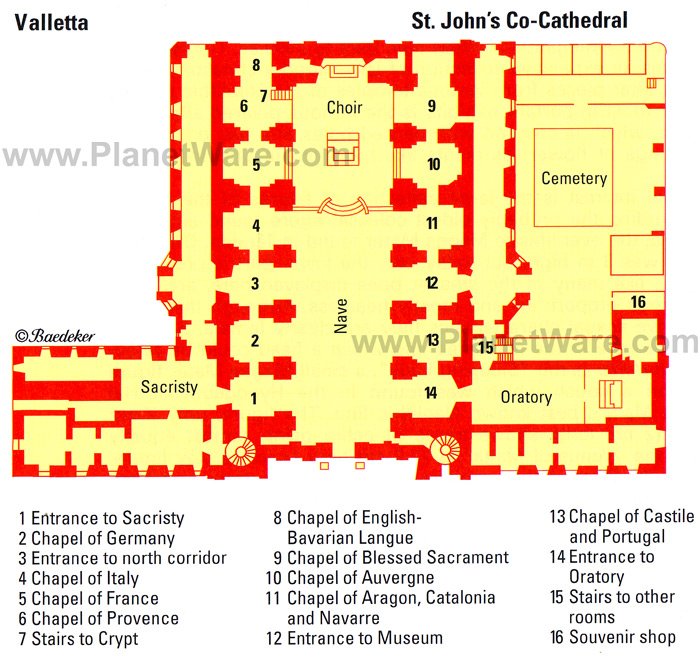Youtube
Uploaded on 10 Mar 2009
St.John Co-Cathedral Valletta Malta

Blessed Sacrament
The
Chapel of the Blessed Sacrament, also known as Our Lady of Philermos, is a much
venerated chapel. The most important remaining work is the Renaissance Cross,
dating from 1532. Tradition says the silver gates, which were a gift in 1752
from two knights, were painted black to resemble course iron when Napoleon was
looting St John's.
This chapel was one of the most important
chapels for the Knights as this is where the icon of the Madonna of Philermos
was kept. This icon drew great devotion as it was believed to be miraculous and
had been in the possession of the Order since the Knights were in Jerusalem.
Before battle this were the Knights prayed and when victorious the key of the
fortresses captured would be presented to the Virgin where they still hang to
this day. Amongst them are the keys of the castles of Lepanto and Patras.
·
Baptism
of Christ, 1700-1703,
Valletta, main altar of St. John's Co-Cathedral.
Sicilian bronzaro
Giovanni Giardini was also cleaned and re-gilded
Facebook
The large
marble statue of the Baptism of Christ by Giuseppe Mazzuoli
The High Altar and the Gloria
underwent restoration in 2000 with the collaboration of the Metropolitan
Cathedral Chapter, the Ministry of Education, the Italian Embassy, the Istituto
Italiano di Cultura and St John’s Museum, under the direction of the Museums
Department and the National Museum of Fine Arts, Valletta. Restorations were
entrusted to Sante Guido.
The High Altar restoration
consisted...
The High Altar restoration consisted of the
cleaning of the miniature angels, gilt bronze statuettes of vine leaves and
corn ears as well as an extensive clean-up of the altar’s precious marble. The
altar was designed and made in Rome by Gio Battista Contini and assembled
locally in 1686. It is considered to be one of the most impressive and opulent
altars of the Baroque era. The large
marble statue of the Baptism of Christ by Giuseppe Mazzuoli was also cleaned
from the accumulation of several layers of candle soot. The gilt bronze Gloria
made by the Sicilian bronzaro Giovanni Giardini was also cleaned and re-gilded.
http://www.stjohnscocathedral.com/
Chapels[edit]
A Cathedral's chapel
The Cathedral contains seven rich
chapels, each of which was dedicated to the patron saint of the 8 langues (or
sections) of the Knights. On the left side of the church there are the
following chapels;
1. The Chapel of the
Anglo-Bavarian Langue was formerly known as the Chapel of the Relic where the
Knights used to keep relics that they have acquired through the centuries.
3. The Chapel of France is
dedicated to the Conversion of Saint Paul. This
chapel was modified in the 19th century. The monuments found in this chapel are
those of grandmasters Fra Adrien de Wignacourt and Fra Emmanuel de
Rohan-Polduc.
5. The Chapel of Germany is
dedicated to the Epiphany of Christ. The titular paint is by Stefano
Erardi, a Maltese painter.
6. On the right side of
the church there are the following chapels;
7. The Chapel of Blessed Sacrament was formerly known as the
Chapel of Our Lady of Fileremos (Rhodes). The titular painting of this chapel
is Our Lady of Carafa which is a copy of Our Lady of Lanciano. Among the knight
buried in this chapel there is Fra Gian
Francesco Abela and
Fra Flaminio Balbiano.
8. The Chapel of Auvergne is dedicated to Saint Sebastian.
The only monument in this chapel is that of Fra Annet de Clermont.
9. The Chapel of Aragon is
dedicated to St. George. The
titular painting was painted by Mattia Preti and it is considered as one of his
masterpieces. In this chapel one can find the monuments of the following
grandmasters, Fra Martin de Redin,
Fra Raphael Cotoner,
Fra Nicolas Cotoner,
Fra Ramon Perellos.
10.
The Chapel of Castile, Leon, and Portugal dedicated
to James the Greater. The monuments in this chapel are those of grandmasters
Fra Antonio Manoel de
Vilhena and Fra Manuel Pinto da
Fonseca.
Other
works of art[edit]
http://en.wikipedia.org/wiki/St._John%27s_Co-Cathedral
The Beheading of St John the Baptist
by Caravaggio.
St John the Baptist’s Passion
is celebrated on August 29.
File:Michelangelo-Caravaggio
021 Beheading-of-St-John-the-. Back in June we celebrated the nativity of St.
John the Baptist, the only birth we observe on ...
Detail of the Beheading of
John the Baptist painted by
Caravaggio in 1608
(Valletta, St. John's Cathedral).
(Valletta, St. John's Cathedral).
&&&&&&&&&&&&&&&&&
FACEBOOK: Pictures and collage.
The painting of The Beheading of St John the Baptist - before and after restoration





.jpg)

.jpg)














